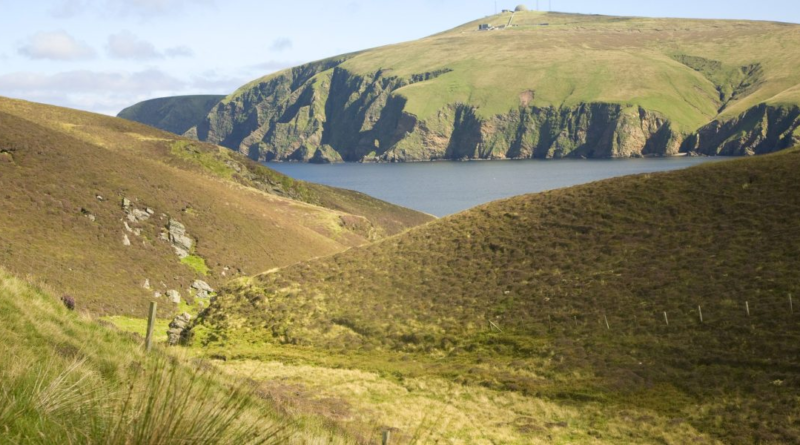Tiny Scottish island, with more sheep than people, becomes the U.K.'s first spaceport for vertical rockets
When Frank Strang visited SaxaVord nearly 20 years ago, he was so enamored with the Scottish property that he purchased it on the spot without even telling his wife.
Now, the unlikely entrepreneurial duo is on the verge of opening Europe’s newest space hub. It occupies a former military station on the island of Unst, some 400 miles (640 kilometers) north of Edinburgh. The few people who choose to live there are vastly outnumbered by sheep, rabbits and the whales and dolphins that frolic in the cobalt seas surrounding the rocky coast line.
The Royal Air Force opened a radar station at SaxaVord in the late 1950s to warn the mainland of any oncoming aircraft approaching from the sea. It closed in 2006, throwing the small population into serious economic hardship.
Strang, 66, was no stranger to life in the military, having met his wife, Debbie, three decades ago when they were both in the RAF. So when he got an offer to buy the land after the military complex was decommissioned, Strang seized the opportunity, with no real plan of what to do next.
“It was a bit of a whim, an educated punt,” he says. “Never for one minute did I think we’d be building a spaceport.”
But when the government said it was looking for spaceport sites, Strang jumped at the chance given SaxaVord’s geographical advantages and his background in aviation and defense. Construction of SaxaVord’s future began in earnest in mid-2022.
Since buying SaxaVord, the Strangs have sought to make the place more cozy — not an easy task given that the drab military housing and storage facilities exude Death Star chic. There’s an assembly of low-slung, gray houses that come with an abandoned fern-green turret that still guards the streets.
The ruggedness of the place notwithstanding, the Strangs say they have cooked up a winning formula that blends tourism with their space dreams. They envision SaxaVord as a one-of-a-kind attraction with vacation houses, a hotel, a restaurant, wellness retreats and a gin distillery in addition to three launchpads. By luring space nerds and outdoor enthusiasts, they hope to create a year-round revenue stream to supplement the income they’ll get from seasonal launches.
Even today, SaxaVord retains much of its military heritage. The place is barren — Viking archaeological sites and Cold War-era buildings are scattered across the mossy hills. Employees are laser-focused and on point. Instructions are delivered at a rapid clip, packed lunches are clearly labeled, food options are minimal. This is serious space stuff, after all. Anyone looking for a yoga-themed spa should stick to the mainland.
SaxaVord is one of seven spaceports being built around the UK in the wake of new laws encouraging private investment in the space industry. In December, it became the first fully licensed site in Western Europe for vertical launches to take satellites into space. The Strangs are allowed to host up to 30 launches a year, and the first — from German startup Rocket Factory Augsburg AG — may be ready to go as soon as August. It would be the first vertical orbital rocket launch from British soil, a milestone for a country that has long trailed in the global space race.
But it’s going to take a lot more money to turn the Strangs’ dream into a reality. Frank Strang says construction has cost about £48 million ($61 million) so far, and he estimates they’ll need another £100 million to finish the runway and hotel. He thinks it will take another decade to build all the planned amenities, and he doesn’t expect the spaceport to turn a profit for two years.
The money has so far come from private investors including Danish billionaire Anders Holch Povlsen, other individuals and small funds. One of the launchpads is named after Povlsen’s late son, Fredo.
Strang says they were “badly let down” by a US fund recently and they started to run out of cash. As they were doing another investor round, the UK government stepped in with a £10 million award in March to help get rockets off the ground. The remaining money will likely come from a mix of private and public sources, he says.
Since the government’s backing, “we’ve now got lots of new best friends wanting to talk to us who didn’t believe in us before,” says Strang. He hopes to take SaxaVord public “at the right time.”
There’s a flurry of activity happening now as the spaceport prepares to host the UK space minister for a ribbon-cutting ceremony on May 29. The first stage of RFA’s rocket is already on one of the launchpads, looming in the windows of the vacation cottages that house staff and clients. It had to be transported to SaxaVord in parts: first driving across Germany and crossing the English Channel, then driving to the Aberdeen cargo ferry before finally reaching Shetland.
Ahead of the launch, SaxaVord needs to expand its 75-person workforce and hire up to 40 more people to serve as security staff, stewards, housekeepers and technical support, Strang says. Finding workers is challenging given the sparse population on the island. Some of the youngest staff members are on internships.
Some businesses on the island are already seeing benefits from the spaceport. A local tea room that used to be open just during the summer now has enough business with SaxaVord clients that it stays open all year. Strang says an elderly woman he met on the ferry told him that “Unst needs space” since the airfield closed and the salmon industry that’s there now could also disappear.
Unst is Britain’s most northerly inhabited island. Getting there requires an epic journey that involves multiple flights and ferries from England, followed by a three-hour car ride across windswept islands to a spot so remote it feels otherworldly in its own right.
In their mission to meld space with tourism, the Strangs want to transform the current amenities into a modern complex with Scandinavian-style interiors. The plans, which they’ve already presented to Shetland Islands Council, include a circular building with offices, accommodations, a restaurant and a viewing platform all sitting on top of an underground parking lot.
“It’s not going to be like a NASA launch in Florida but it can be a smaller version,” says Jodi Bartin, chief executive officer of Citicourt, a financial adviser who says she has helped the Strangs raise money.
In the meantime, customers have been lining up. Lockheed Martin Corp. and British rocket firm Skyrora Ltd. plan to launch from SaxaVord’s 87-hectare site later this year. Skyrora CEO Volodymyr Levykin says he wants to work up to eight launches per year, all in the Strangs’ backyard.
At least five US launch providers have approached SaxaVord over the last three years for space missions, along with companies from Europe, Africa and Asia, Strang says. He expects the spaceport will also support NATO and US government launches in the future.
There are plans to build a viewing platform on a nearby hill. In the meantime, Scott Hammond, deputy CEO of SaxaVord, says tourists who want to witness the first few launches will be lucky to snag a seat on one of the limited daily ferry crossings over the islands. “I think they’re going to be gold dust, those tickets,” says Hammond, an ex-fighter pilot who met Strang in the RAF.
Other UK spaceports such as Cornwall in Newquay will focus on horizontal launches, where rockets can piggy-back on specialized aircraft. Sutherland, located just to the south, is the home base for orbital launch service Orbex and has authorization for up to 12 launches a year but is still awaiting an official license.
Strang sees no pressure from competing spaceports. “We’re going to be full,” he says.
For the moment, he’s focused on finding the “sweet spot” of putting enough money into the business to attract customers without going broke and fizzling out.
“If you snooze, you definitely lose in space,” Strang says.




